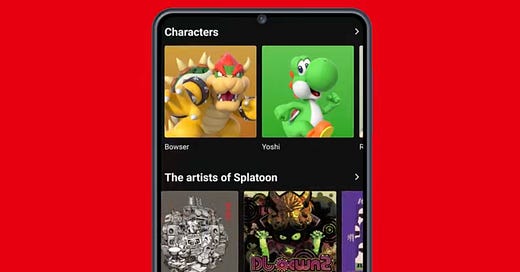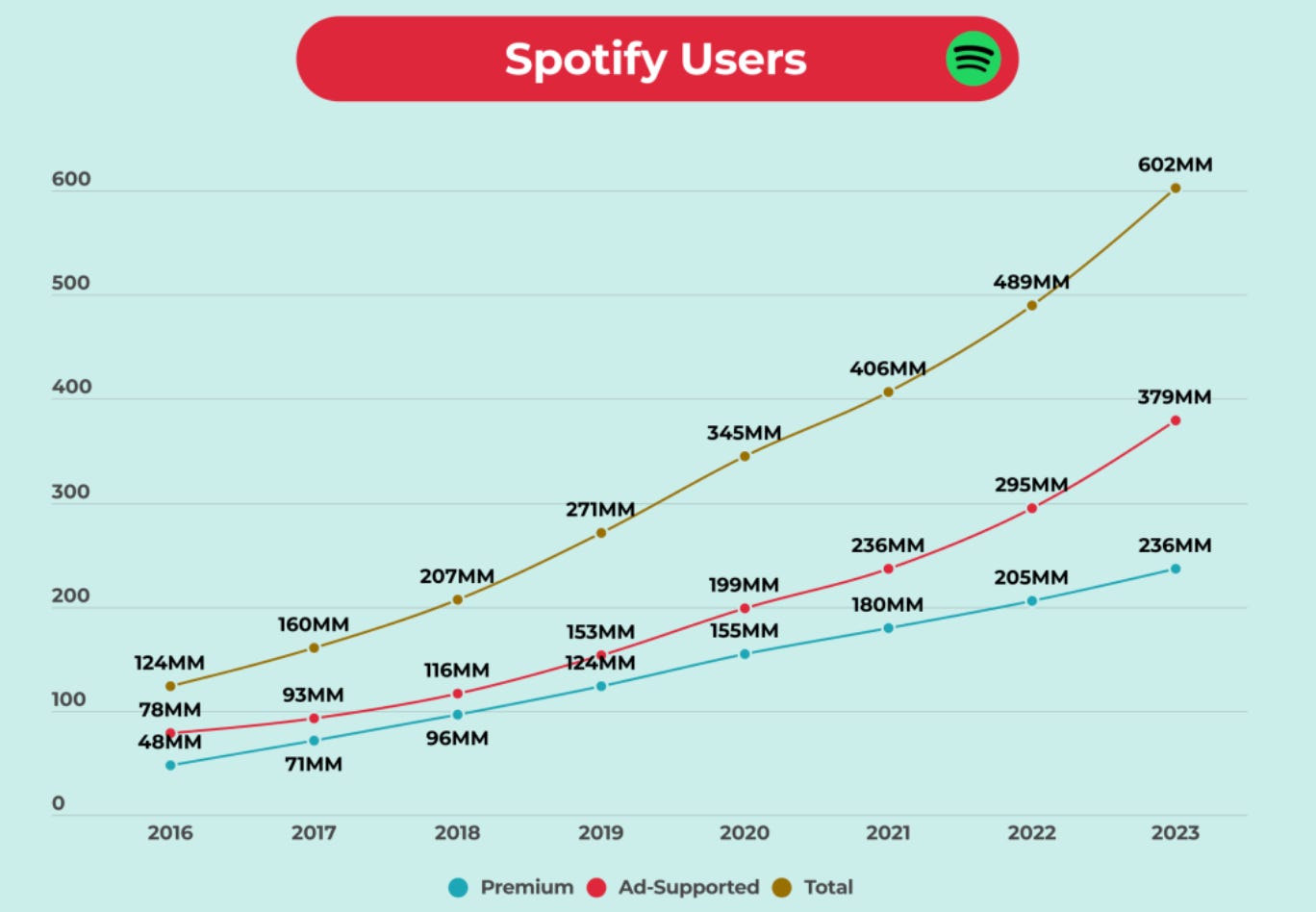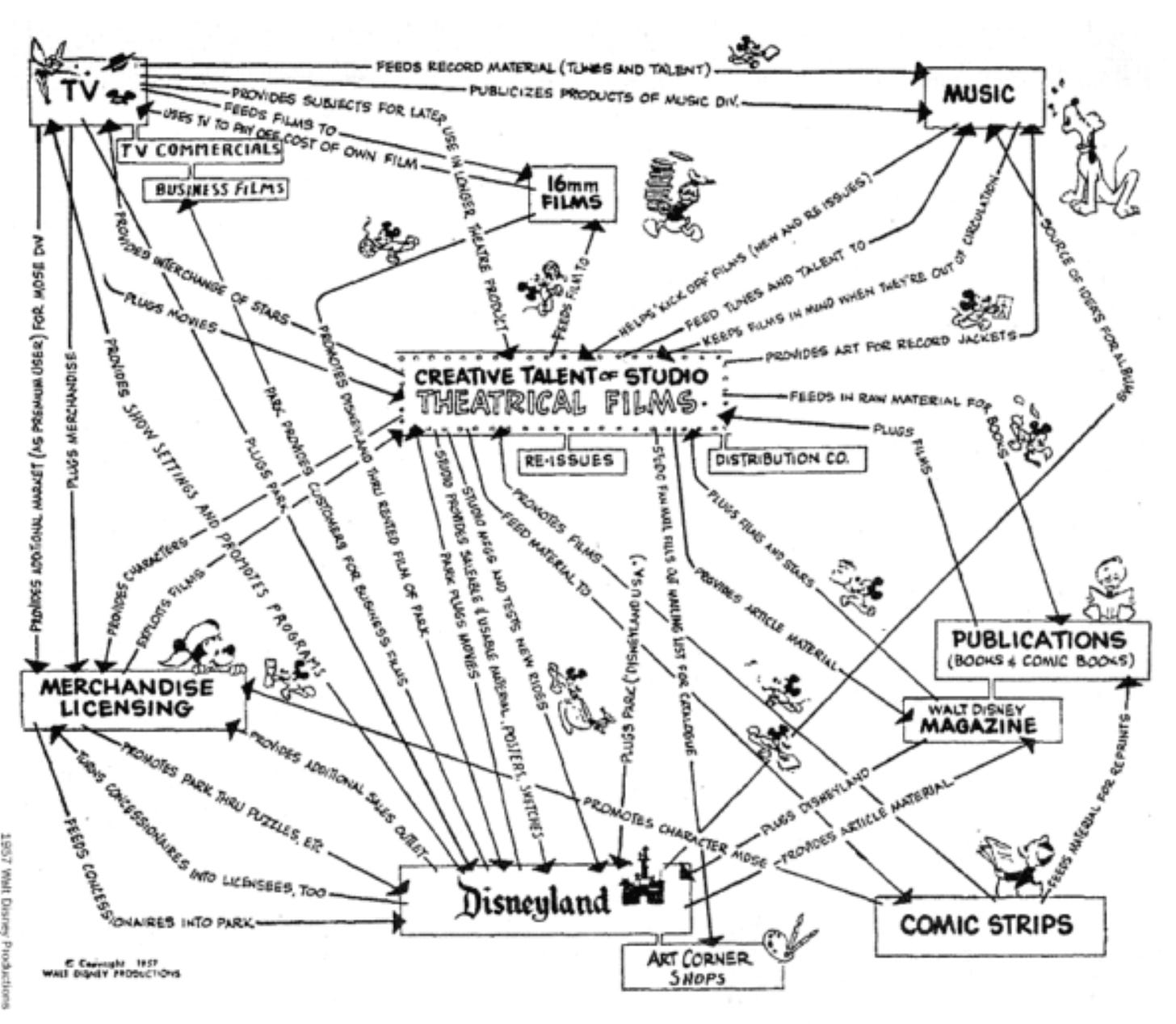How Nintendo Music Potentially Outlines the Future of Media
An app that lets me cry to music from The Legend of Zelda whenever I want? Sign me up, brother
There are two trains of thoughts when it comes to platforms with near monopolistic control over user populations: join ‘em if you can’t beat ‘em, or build against them.
Why pursue one avenue and not another partially depends on whether providing access to valuable content (defined by consistent or growing demand versus declining or limited supply) is more beneficial or destructive to the longevity of a brand. Does having your content on YouTube help (reach) or hurt (uncontrolled environment for related content)? Another part of the equation is network effect. Will having access to a platform or company’s reach — Meta’s three products (Facebook, Instagram, and WhatsApp) and its combined 3.29 billion daily users, or about 41% of the planet’s total population — allow a product or brand to grow? Probably. Does the tradeoff of that reach, however, wind up being that you lose your direct relationship to your audience? Definitely. Which one matters more, and at which point in the product life cycle?
Most companies have opted to work with the largest platforms for obvious reasons. It’s harder to compete with Spotify by building an alternate version. Why try and take some of YouTube’s audience when they’re content watching certain types of videos there? One company that hasn’t, and one that provides a uniquely compelling case, is Nintendo. The company is infamous for not just placing its content on popular platforms of the day. Nintendo operates a YouTube channel (more than 15M subscribers) which it treats as a pure marketing arm to take advantage of the platform’s reach to push people toward its own products that reward those looking for a unique and different (interactive vs passive) entertainment experience. But Nintendo doesn’t have scores from its array of games available on YouTube. Nor are they available on Spotify or Apple Music.
Instead of further helping Spotify’s brand instead of protecting its own, Nintendo launched its own Music App. I’ve included screenshots and an intro video above. Nintendo Music, on the one hand, is another Nintendo standalone digital product emerging out of the corpses from previous apps including the 2016 social game Miitomo and quirky products like the Power Globe. On the other hand, I fucking love it — and there are four specific reasons why:
It creates further reliance on the integrated Nintendo ecosystem without feeling like a cash grab for casual fans
Nintendo further protects the value of its most sought after features of its properties by removing them from easily accessible, and therefore easily customizable, venues such as YouTube or Spotify
Apps like Nintendo Music feel like added perks for Nintendo Switch Online subscribers, increasing the value of that central plan to Nintendo’s growth strategy
It remains true to the Nintendo brand experience across the world
Build Trust, Never Let It Go
For Nintendo, trust is everything. The company ranked within the top 10 most trusted brands in a Morning Consult report from 2023. Another ranked Nintendo as the 12th most trusted brand out of 100 companies, bested in its category only by Lego, the number one most trusted brand in 2024. That brand trust is a significant reason as to why it took so long for Nintendo to agree to work with third-party companies, like NBCUniversal, on film adaptations of its most precious franchises. And that brand control is still visible in the approach to these new ventures.
Shigeru Miyamoto, the creator of Super Mario Bros. and Nintendo’s legendary game designer, worked closely with Illumination and directors Aaron Horvath and Michael Jelenic on their Super Mario Bros. Movie adaptation. It paid off. With a Rotten Tomatoes score of 95% (critics score of 59%) and more than $1.36 billion at the global box office, The Super Mario Bros. Movie was a success in a new world that Nintendo executives knew they had to exist in — but they also knew they couldn't relinquish control. Otherwise it would end up like, well, that other Super Mario Bros. movie. For a long time, Nintendo’s film ambitions were seen as a joke because of the low quality failure that shifted perception of Nintendo as a top notch brand to a company that can only do one thing well. That doesn’t work in a 21st century attention economy.
So what does Nintendo’s move into a Music app tell us about the surveying they conducted (the cost and risk analysis of launching an app versus striking what may have been a pretty lucrative deal with a YouTube, Spotify, or Apple Music for exclusive access) before choosing to go the route of an O&O platform suggest about the company’s business philosophies and strategies? Quite a bit, actually. First off, it tells us there’s a demand for it that Nintendo believes can be capitalized on for a significant period of time. The chart below demonstrates spikes in queries for “stream Nintendo music” between 2004 and 2024. While there have been a few spikes over the years, notably in 2011 when The Legend of Zelda: Skyward Sword came out, and again in 2017 when Super Mario Odyssey and The Legend of Zelda: Breath of the Wild were released, we see a more steady demand of interest between 2020 and 2024. That doesn’t even take into account the revival of Nintendo music-related memes, like the Wii remixes that became popular again around 2016.
The question is why did those sudden spikes turn into a more consistent demand? The next chart provides some of those answers. Although streaming music, and in particular Spotify, was readily available in 2016 in the United States and other regions, it wasn’t until 2020 that the company saw immense growth. It’s the same activity we saw with other streaming platforms, like Netflix, and it’s the period where network effects started to kick in for Spotify. More people used Spotify to create playlists they could share, more people switched to Spotify as their preferred, dominant platform and, as such, more people were using Spotify as a means to find the music they wanted. Spotify maintains a 36% share of all online music streaming, more than double that of its next competitor Apple Music, but music streaming in general has grown from 304.9M global users in the first half of 2019 to more than 713 million in the second half of 2023, according to Statista.
As demand for streaming music and streaming availability grew, so did queries on Google like “where to stream Nintendo music?” That’s aforementioned Statista growth of more than 130% in less than five years, and clearly provided a new market Nintendo was ready to capitalize on. Still, why build its own app instead of relying on the tech stack and network effect of others? The answer lies with Walt Disney.
We talk about flywheels a lot in the media industry and that’s because flywheels are to business what energy is to the Energizer Bunny. It’s the gift that just keeps giving. But the flywheel’s actual superpower has become tainted over the last decade or so. It isn’t just that a character or IP is expanded into different mediums with different audience entry points. A video game based on a comic book based on a movie based on a book. You get the idea. A flywheel, based on Walt Disney’s original concept (seen in the infamous diagram below) was to find new opportunities to build upon the love that people have for the set of characters they’re introduced to however they’re introduced. It couldn’t feel like a money grab. Look how that panned out for the comic book industry in the late ‘90s. No, it has to feel like the new product is feeding into another world that creates an all encompassing lifestyle set in wonderful technicolor and surround sound.
Walt also knew that in order to benefit fully from the flywheel he envisioned, he needed to have almost full creative control over every piece and centralize it as much as possible. Now, there were areas that Disney couldn’t necessarily assert total control over at the time this chart was created. TV distribution wound up in control of the telecom and cable companies. Major music publishers consumed every small label. But ensuring that the creative spirit of Disney felt consistent throughout every distribution pathway that came from the official company ensured top quality control — a truly premium product — that fans could expect from any experience. This trust further encouraged customers to seek out new experiences (cruises, for example), and allowed Disney to expand into a wider array of business lines.
Nintendo’s strength is that it’s almost completely recreated this flywheel piece by piece by focusing on the same concerns and striving to achieve the same goals. Nintendo didn’t just go in blind when trying to figure out a more immersive experience for fans; it created a theme park destination through a partnership with Universal Studios where it maintained as much creative control as possible. Consider what Miyamoto told IGN in 2021:
“The business of creating or running a theme park is very big and very different from what Nintendo does, which is create and sell games. And I thought, 'It's going to be difficult; Nintendo's not going to be able to run a theme park business.' … So I'm really glad that we were able to come to this relationship where we can really have a collaborative partnership.”
It worked. IGN’s review of the park specifically calls out that you can feel the Miyamoto (ie, the Nintendo influence) upon entering. Sometimes, however, the right move is knowing when not to partner with a company. Nintendo’s focus on Music means finding the best way to capture the understood value of those songs and the library collection the company has amassed.
Remember, Nintendo doesn’t want people to leave its magical world full of distinct and vivid memories. Spotify and YouTube provide a risk that other partners may have, and Nintendo, a gaming-slash-entertainment-slash-tech company could theoretically build an app with much more ease and less upfront investment than, say, constructing an entire park. One keeps Nintendo firmly in the entertainment business; the other shifts Nintendo into the world of real estate development. Even Miyamoto acknowledges in the above quote that Nintendo’s strength is in knowing where the company can’t succeed.
Part of the reason I’m drawn to Nintendo Music as a potentially precious product is because, in many ways, it represents the future. Media companies will increasingly have to choose what to own and what to co-pilot. Not every new venture needs to exist as an O&O product, nor does it have to exist within a centralized environment. Licensing out characters to various retailers, or allowing small merchants to use beloved characters in their own designs sought out by different customer groups fosters an evergreen love that’s so incredibly challenging to manufacture out of thin air.
Other ventures, however, like Nintendo Music speak to recognizing and betting on a new experience that fosters engagement, activity, and subscriptions within a new ecosystem, letting the player, viewer, or listener dive heart first into a world of escapism they’re seeking out. Nintendo Music may not ever be as popular as Nintendo Switch Online for obvious reasons, but the fact that Nintendo’s executives know they’re sitting on a pile of treasure that fans from all over will continue to seek out for years to come makes this one of the better media moves.
Think about the day in the life of a Nintendo fan: you wake up to your Nintendo Alarmo clock. You throw on a playlist from Nintendo Music while biking to school. You trade Pokémon with your friends using your Nintendo Switch at recess. You race home to play some Mario Party with your younger sister. Before going to bed, you watch the Super Mario Movie for the hundredth time, and then go to sleep with the sounds of The Legend of Zelda playing in your ear while thinking about your trip to Super Nintendo World. That kind of affection, and that kind of attention, is something almost every other media company would kill for.







